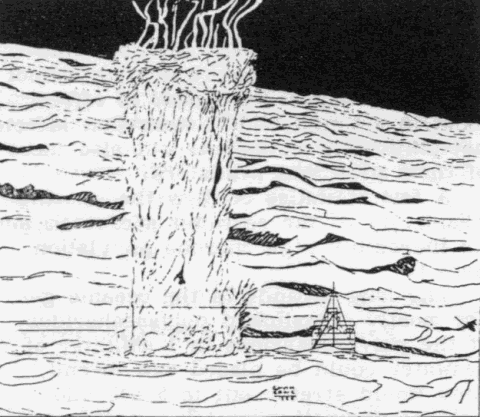 |
Science Frontiers ONLINE No. 134: MAR-APR 2001 |
|
|
Weird Waterspout?
G. Craig was the helmsman on the Cape Horn during a powerful storm (winds of Force 9-10, seas running 8 meters high). Even at 4 A.M., the phosphorescence of the breaking sea made it seem like daylight.
At 4:30, Craig saw what he thought was a colossal wave forming. It was so large that the vessel seemed certain to capsize. He thought he was a goner. But, strangely, the "wave" closed with the vessel very slowly and seemed to move independently of the rest of the stormy sea. Craig recalled other strange features of the phenomenon:
...what I had initially mistaken for wave crests were actually widely-spaced 'geysers', dancing on the upper surface and each rising to a height of about 20 feet. dropping to half of it, then rising again. [See Craig's sketch.]
Then, suddenly, when all seemed lost, the wind dropped from a full gale to an eerie calm. The "wave" passed -- gently -- and then the storm resumed. The Cape Horn was drenched, but there had been no shattering of glass nor rending of wood. There was some flooding but no more than usual in very heavy seas. Some of the lumber lashed to the deck had been lost, but, overall, damage was minimal. The seemingly catastropic "wave," topped by the peculiar geysers turned out to be only a hollow threat, and the "wave's" hollowness may be a clue to its true nature.
(Craig, Gavin; "Surviving a Giant Sea--Did the Ship Strike a Waterspout?" Journal of Meteorology, U.K., 25:241, 2000.)
Comment. Indeed, hollowness is characteristic of a waterspout. They are fierce on the outside but calm inside. A trip through a genuine waterspout, as described in SF#49, yielded a similar account of impending catastrophe but in the end only a gentle passage. The Cape Horn had apparently been hit dead on by a waterspout.
But the strange geysers atop the 'wave' or spout deserve an explanation that we cannot provide.
 G. Craig's sketch of the ominous "wave" topped by "geysers." It was not as catastrophic as it seemed.
G. Craig's sketch of the ominous "wave" topped by "geysers." It was not as catastrophic as it seemed.
|
Other Sites of Interest
|